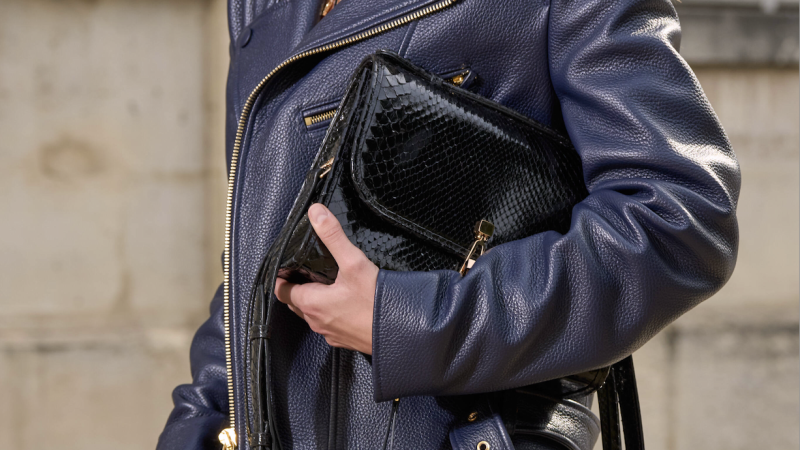Copyright Cable News Network

Leather has been a staple of human fashion for millennia, but the fashion industry is increasingly embracing more sustainable alternatives. Traditional leather comes mainly from cows, and cattle farming is linked to deforestation, habitat loss and land degradation. The tanning process is polluting and can use up to 50,000 liters (13,209 gallons) of water for each ton of raw animal hides. Vegan and lab-grown leathers are on the rise, but one US company is supplying fashion houses with the real thing — only rather than using cattle, it’s sourced from invasive exotic animals. Pythons from Florida’s Greater Everglades, silverfin carp from the Mississippi River Basin and lionfish from Caribbean reefs are the three alien invasive species that Miami-based startup Inversa currently harvests. The leather it produces is eventually turned into products such as clothing, bags and other accessories by fashion brands such as Gabriela Hearst, Khaite, Catherine Holstein and Johanna Ortiz. “This all starts with a fish,” said Inversa CEO Aarav Chavda, who co-founded the company in 2020. “I’ve been a scuba diver for almost 15 years now, and I’ve just been obsessed with the problem of the invasive lionfish and what it’s doing to coral reefs throughout the Caribbean and the Mediterranean — taking a sledgehammer to native biodiversity on those reefs.” Invasive species are animals and plants that are introduced due to human activity to an area where they are not native. They end up harming the local ecosystem, for example by eating native species, spreading disease or outcompeting other organisms for food or resources. They can cause extinctions and irreversible damage to the environment. “My co-founders and I firmly believed that one way to solve this problem was to tap into the power of the consumer,” Chavda added. “We then zeroed in on the fashion industry — it really wants to do better and it’s looking for healthier and more sustainable feedstock materials. We ended up turning the lionfish into leather, and that was the genesis of this wonderful idea. I’m here to make a structural impact on invasives, which the UN considers to be a top five driver of biodiversity loss.” Invasive menace After an initial focus on the lionfish, Inversa started harvesting silverfin, a carp native to China that was imported in the US in the 1970s, mostly to control algae in municipal sewage lagoons. However, it soon escaped into the wild: “In the Mississippi river ecosystem it’s completely decimating native biodiversity,” Chavda said. “It consumes an unbelievable amount of native vegetation and biomass and it’s now in several US states — it’s a major problem.” The Burmese python soon followed: “It’s a constrictor snake originally from Southeast Asia, which was released into the Florida Everglades in the 1990s,” Chavda said. The snakes, likely from the pet trade, quickly multiplied and turned into super-predators, leading to the collapse of the populations of native mammals like raccoons, opossums and bobcats. Inversa manages a network of hunters who procure the invasive species, and then processes the skins in three tanning facilities — two in Europe and one in the US. The system is managed through a digital platform called Origin, which integrates real-time field data, satellite imagery, predictive modeling, and AI-driven invasion mapping, with the goal of streamlining the operation and allowing traceability of every product: “We are building a completely transparent, traceable and verifiable supply chain, all the way back to the hunting itself,” Chavda explained. Chavda noted the tanning process is different from using cow hide — especially for fish skin, which is made up of very thin but also very strong fibers. He added that Inversa is working with about 50 fashion brands and will soon expand into even more species, which he plans to announce next year. The company mandates that the final products mention either its name or the fact that the leather is sourced from an invasive species, and it states that this method of leather production offers an 89% improvement on carbon emissions and brings land use to almost zero. Inversa said that it adheres to humane killing practices and is backed by American nonprofit environmental organization Conservation International and The National Oceanic and Atmospheric Administration, among others. Chavda said Inversa has removed tens of thousands of invasive animals. However, there is no definitive assessment on the effect of these removals on the habitats: “In the Everglades, we’re seeing anecdotal increases in native mammals in the areas we’re hitting hard, from our hunters. We can definitely tell that the alleviated pressure is helping.” Inversa’s work was assessed by the World Wildlife Fund (WWF) Switzerland, which found it had a positive impact on biodiversity. “Despite contributing to 60% of species extinctions and causing $423 billion in economic damages annually, invasive species remain largely overlooked in conservation funding,” said Sybille Borner of WWF Switzerland. “The (assessment) highlights Inversa’s ability to fill parts of this critical gap, demonstrating how fashion can be an unexpected yet powerful force for biodiversity.” Raising awareness Alexandra Ioanid, an associate professor at the National University of Science and Technology Politehnica Bucharest, Romania, who has done research on invasive species and is not involved with Inversa, said that turning invasive species into a valuable material addresses two challenges at once: “It helps reduce the ecological damage caused by species that threaten native ecosystems, and it offers a more sustainable alternative to conventional leather. Technically, it’s exciting to see that leather made from invasive species can reach the quality and versatility required for real-world use.” With the right tanning methods, Ioanid added, these alternative leathers can perform on par with traditional materials — and have a distinctive texture and aesthetic of their own: “If done responsibly, such initiatives can create economic incentives for removing invasive species, support local livelihoods, and contribute to conservation goals. The key is maintaining traceability and ecological oversight to ensure that these materials genuinely help manage invasives rather than encouraging new harvesting.” However, selling materials sourced from wildlife, non-native or not, can stimulate markets that promote unrestricted or incentivized killing, encourage intensive wildlife farming and trigger unintended consequences, such as the deliberate release of these species to sustain supply, according to PJ Smith, fashion policy director for Humane World for Animals, a nonprofit that fights animal cruelty. “Wildlife conservation efforts should prioritize the development of effective nonlethal management strategies that provide long-term solutions to address negative impacts from non-native species over fueling demand for luxury goods. There is a growing consumer demand for true, sustainable, bio-based leather alternatives that are animal-free and help restore ecosystems without the exploitation,” Smith added. Deah Lieurance, an assistant professor of Invasive Species Biology and Management at Penn State University, said that the populations of invasive species that Inversa harvests are so high that she’s doubtful the company could have any significant impact on restoration: “I do think these types of projects do have one major benefit,” she added, “they bring greater public awareness to the wicked problem of biological invasion.”



